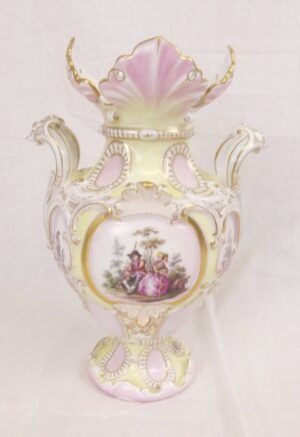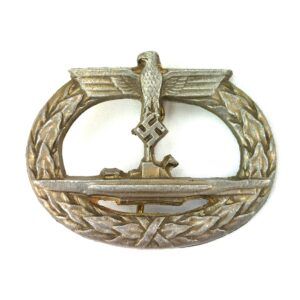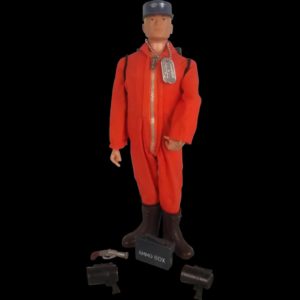*German, WW2, Type IX U-Boat – Small Brass Relief Plaque*
Approximate Measurements:
Frame: 19cm x 8.4cm
U boat: 15.8cm x 3.8cm
A small brass relief of a U-boat, likely a Type IX submarine, is mounted on black velvet within a wooden frame. A nearly identical plaque has been seen labelled “La Pallice,” referencing the U-boat bunker at La Rochelle.
U-Boats in World War II
U-boats were German naval submarines, the term derived from the German “U-Boot” (short for Unterseeboot, meaning “under-sea boat”). While also used for Austro-Hungarian submarines, the term is most associated with German wartime subs. During World War II, Karl Dönitz, supreme commander of the Kriegsmarine’s U-boat arm, advocated for defeating the UK by targeting convoys. Initially successful in the Battle of the Atlantic, U-boats inflicted heavy damage on Allied shipping. However, improved Allied strategies, such as high-frequency direction finding and the Hedgehog anti-submarine system, began to counter the U-boat threat. This decline culminated in May 1943, termed “Black May,” when U-boat losses surpassed their impact on Allied operations.
La Pallice: A Key U-Boat Base
La Pallice, the main port of La Rochelle, was a vital base for German U-boats during the war. Construction of its massive U-boat bunker began in April 1941 and was completed within two years. The bunker measured 192 by 159 meters and featured a double-layered roof: the lower layer was 3.5 meters of reinforced concrete, while the upper layer comprised concrete beams spaced 1 meter apart. The roof’s total thickness was 7.3 meters above pens 1–5 and nearly 6.5 meters above pens 6–10.
The 3rd U-boat Flotilla, relocated from Kiel to La Pallice in October 1941, operated from this facility. Among its stationed submarines were several Type IX U-boats, designed for long-range missions. For example, U-444, a Type IX U-boat, departed La Pallice for its second and final patrol on March 1, 1943.
La Pallice’s strategic importance waned after the Allied landings in Normandy in June 1944. By August 1944, the 3rd U-boat Flotilla withdrew to Norway.
The Type IX U-Boat
The Type IX U-boat, designed by Nazi Germany’s Kriegsmarine between 1935 and 1936, was a long-range ocean-going submarine created for operations far from home bases. Based on the earlier Type IA, it underwent numerous modifications and appeared in several sub-types.
Type IX U-boats had six torpedo tubes—four forward and two aft—and carried six internal reloads. Five external torpedo containers (three aft and two forward) provided storage for 10 additional torpedoes, enabling prolonged attacks on convoys over successive nights. Some IXC variants were equipped for mine-laying, capable of deploying 44 TMA or 60 TMB mines.
Secondary armament included a 10.5 cm (4.1 in) deck gun with 180 rounds, while anti-aircraft weaponry varied throughout the war. Early models (IXA and IXB) had two periscopes in the tower and a third in the control room, which was removed in later versions like the IXC. These long-range submarines were often fitted with the Focke-Achgelis Fa 330 rotor kite, a towed rotary-wing aircraft used for reconnaissance.
*Condition*
Very good used condition. Please see photographs as part of the condition report.
RQMAEOXBDO_1146192843












